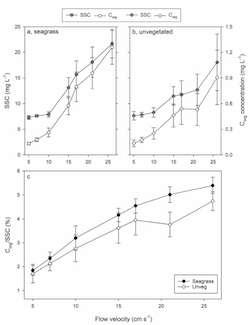ABSTRACT
Hydrodynamic processes are important for carbon storage dynamics in seagrass meadows, where periods of increased hydrodynamic activity could result in erosion and the loss of buried carbon. To estimate hydrodynamic impacts on the resuspension of organic carbon (Corg) in seagrass-vegetated sediments, we exposed plots of Zostera marina (with different biomass, shoot densities and sediment properties) to gradually increased current flow velocities ranging from low (5 cm s–1) to high (26 cm s–1) in a hydraulic flume.
We found that higher flow velocities substantially increased (by more than three-fold) the proportion of Corg in the suspended sediment resulting in a loss of up to 5.5 ± 1.7 % (mean ± SE) Corg from the surface sediment. This was presumably due to increased surface erosion of larger, carbon-rich detritus particles. Resuspension of Corg in the seagrass plots correlated with sediment properties (i.e., bulk density, porosity, and sedimentary Corg) and seagrass plant structure (i.e., belowground biomass).
However, shoot density had no influence on Corg resuspension (comparing unvegetated sediments with sparse, moderate, and dense seagrass bed types), which could be due to the relatively low shoot density in the experimental setup (with a maximum of 253 shoots m–2) reflecting natural conditions of the Swedish west coast. The projected increase in the frequency and intensity of hydrodynamic forces due to climate change could thus negatively affect the function of seagrass meadows as natural carbon sinks.










